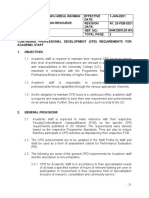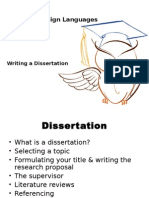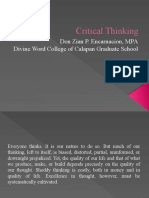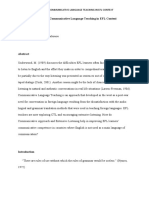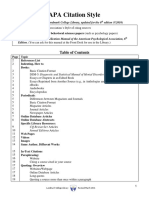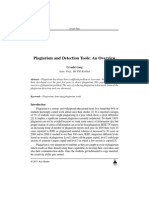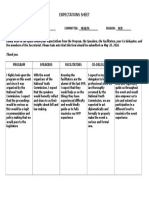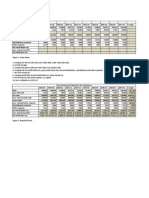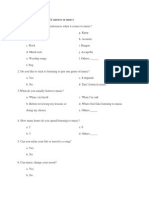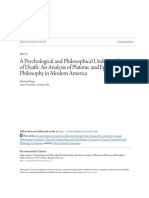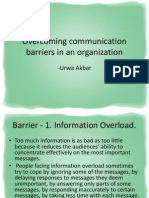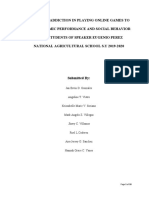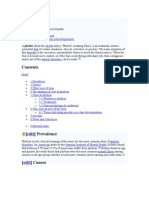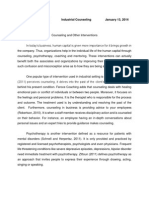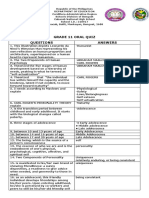Plagiarism Sample Lessons
Plagiarism Sample Lessons
Uploaded by
Michael Angelo SarabiaCopyright:
Available Formats
Plagiarism Sample Lessons
Plagiarism Sample Lessons
Uploaded by
Michael Angelo SarabiaOriginal Description:
Copyright
Available Formats
Share this document
Did you find this document useful?
Is this content inappropriate?
Copyright:
Available Formats
Plagiarism Sample Lessons
Plagiarism Sample Lessons
Uploaded by
Michael Angelo SarabiaCopyright:
Available Formats
How to Recognize Plagiarism
Examples
Word for Word | Paraphrasing
Example 1 of 5 Source: https://www.indiana.edu/~istd/examples.html
A word-for-word example of plagiarism is one in which the writer directly quotes a passage or
passages from an author's work without the use of proper quotation marks.
Read the example carefully!
Original Source Material: Technology has significantly transformed
education at several major turning points in our history. In the broadest
sense, the first technology was the primitive modes of communication
used by prehistoric people before the development of spoken language.
Mime, gestures, grunts, and drawing of figures in the sand with a stick
were methods used to communicate -- yes, even to educate. Even
without speech, these prehistoric people were able to teach their young
how to catch animals for food, what animals to avoid, which vegetation
was good to eat and which was poisonous.
Plagiarized Version
In examining technology, we have to remember
that computers are not the first technology people
have had to deal with. The first technology was the
primitive modes of communication used by
prehistoric people before the development of
spoken language.
Source: Frick, T.
(1991). Restructuringeducation
through technology.
Bloomington, IN: Phi Delta
Kappa Educational
Foundation.
Correct Version
In examining technology, we have to remember that
computers are not the first technology people have
had to deal with. Frick (1991) believes that "... the
first technology was the primitive modes of
communication used by prehistoric people before the
development of spoken language" (p. 10).
References: Frick, T. (1991). Restructuring education
through technology. Bloomington, IN: Phi Delta
Kappa Educational Foundation.
Explanation: This example of student written work
Explanation: Note in this example that the passage
is plagiarized. The student copied, word-for-word,
begins with the author and year of the publication.
text from the original source material. No credit
Quotation marks are used to indicate that this
was given to the author of the text and quotation
passage is a word-for-word citation from the original
marks were not used. Also, the student didn't
document.
provide a reference.
How to Recognize Plagiarism
Examples
Word for Word | Paraphrasing
Example 2 of 5
A word-for-word example of plagiarism is one in which the writer directly quotes a passage or
passages from an author's work without the use of proper quotation marks.
Read the example carefully!
Original Source Material: Constructivism is a movement that extends beyond
the beliefs of the cognitivist. It considers the engagement of students in
Source: Heinich, R.,
meaningful experiences as the essence of learning. The shift is from passive
transfer of information to active problem solving. Constructivists emphasize that Molenda, M., Russell, J.
learners create their own interpretations of the world of information.
D., & Smaldino, S. E.
(1999). Instructional
media and technologies
for learning. Upper
Saddle River, NJ:
Prentice-Hall.
Plagiarized Version
Correct Version
Constructivists do not hold views entirely opposed
Constructivists do not hold views entirely opposed to
to those of the cognitivists. The position of
those of the cognitivists. The position of
constructivists extends beyond the beliefs of the
constructivists "... extends beyond the beliefs of the
cognitivist.
cognitivist" (Heinich, Molenda, Russell, & Smaldino,
1999, p. 17).
References: Heinich, R., Molenda, M., Russell, J.
D., & Smaldino, S. E. (1999). Instructional media
References: Heinich, R., Molenda, M., Russell, J. D.,
and technologies for learning. Upper Saddle River,
& Smaldino, S. E. (1999). Instructional media and
NJ: Prentice-Hall.
technologies for learning. Upper Saddle River, NJ:
Prentice-Hall.
Explanation: This example of student written work
Explanation: Quotation marks are used to indicate
is plagiarized. The student included a portion of the that this passage is a word-for-word citation from the
original author's work in a sentence without using
quotation marks. Although the work was cited in
the references, no credit was given to the original
author in the text of the paper, and quotation marks
were not used.
Source: https://www.indiana.edu/~istd/examples.html
original document.
How to Recognize Plagiarism
Examples
Word for Word | Paraphrasing
Example 3 of 5
A word-for-word example of plagiarism is one in which the writer directly quotes a passage or
passages from an author's work without the use of proper quotation marks.
Read the example carefully!
Original Source Material: The concept of systems is really quite simple. The
basic idea is that a system has parts that fit together to make a whole; but
Source: Frick, T. (1991).
where it gets complicated -- and interesting -- is how those parts are connected
Restructuring education
or related to each other.
through
technology.Bloomington,
IN: Phi Delta Kappa
Educational Foundation.
Plagiarized Version
Correct Version
A system has parts that fit together to make a
Frick (1991) states that "... a system has parts that fit
whole, but the important aspect of systems ishow
together to make a whole ..." but the important aspect
those parts are connected or related to each
of systems is "... how those parts are connected or
other (Frick, 1991).
related to each other" (p. 17).
References: Frick, T. (1991). Restructuring
References: Frick, T. (1991). Restructuring education
education through technology. Bloomington, IN: Phi through technology. Bloomington, IN: Phi Delta
Delta Kappa Educational Foundation.
Kappa Educational Foundation.
Explanation: This example of student written work
Explanation: Note in this example that the passage
is plagiarized. Although the author is cited at the
begins with the author and year of the publication.
end of the paragraph, the student copied word-for-
Quotation marks are used to indicate that the
word from the original source material and did not
passages are word-for-word citations from the
use quotation marks.
original document. The author is also listed in the
references.
Source: https://www.indiana.edu/~istd/examples.html
How to Recognize Plagiarism
Examples
Word for Word | Paraphrasing
Example 4 of 5
A word-for-word example of plagiarism is one in which the writer directly quotes a passage or
passages from an author's work without the use of proper quotation marks.
Read the example carefully!
Original Source Material: Theories differ from philosophies and models of
teaching. A philosophy is a value system, whereas a theory seeks to explain
real-world events and can be certified through scientific investigation. Models of
teaching are approaches to the management of some aspect of classroom
instruction and they may not be independent of subject area, grade level, age
of the student, or the setting for learning.A characteristic of learning theories is
that they address the underlying psychological dynamics of events. Thus, they
provide a mechanism for understanding the implications of events related to
learning in both formal and informal settings.
Plagiarized Version
Source: Gredler, M. E.
(2001). Learning and
instruction: Theory into
practice (4th ed.). Upper
Saddle River, NJ:
Prentice-Hall.
Correct Version
Theories and philosophies are different from each
Theories and philosophies are different from each
other because, according to Gredler (2001) theories
other because theories seek to explain real-world
seek
events and can be certified through scientific
investigation. Learning theoriesaddress the
to explain real-world events and can be certified
underlying psychological dynamics of events,
through scientific investigation... A characteristic of
so they provide a mechanism for understanding the learning theories is that they address the underlying
implications of events related to learning in both
psychological dynamics of events. Thus, they provide
formal and informal settings.
a mechanism for understanding the implications of
events related to learning in both formal and informal
settings. (pp. 12-13)
References: Gredler, M. E. (2001). Learning and
instruction: Theory into practice (4th Ed.). Upper
Saddle River, NJ: Prentice-Hall.
Explanation: This example of student written work
Explanation: An indented block is used to indicate
is plagiarized. The student used several passages
that this passage is a word-for-word quotation and
from the original work and inserted them into
the pages where it was taken from the original
original prose, however this is still an example of
document. The original author of the content is cited
word-for-word plagiarism. No credit was given to
at the end of the passage and in the reference
the author in the text and quotation marks were not
section as well.
used, and also the work was not listed in the
references.
Source: https://www.indiana.edu/~istd/examples.html
How to Recognize Plagiarism
Examples
Word for Word | Paraphrasing
Example 5 of 5
A word-for-word example of plagiarism is one in which the writer directly quotes a passage or
passages from an author's work without the use of proper quotation marks.
Read the example carefully!
Original Source Material: An important characteristic of instructional-design
theories is that they are design oriented (or goal oriented). This makes them
very different from what most people usually think of as theories. Theories can
be thought of as dealing with cause-and-effect relationships or with flows of
events in natural processes, keeping in mind that those effects or events are
almost always probabilistic (i.e., the cause increases the chances of the stated
effect occurring) rather than deterministic (i.e., the cause always results in the
stated effect).
Source: Reigeluth, C. M.
(1999). What is
instructional design
theory and how is it
changing? In C. M.
Reigeluth
(ed.),Instructional-design
theories and models
volume II: A new
paradigm of instructional
theory,(pp. 1-29).
Mahwah, NJ: Lawrence
Erlbaum Associates.
Plagiarized Version
Correct Version
Whether they are probabilistic (i.e., the cause
Reigeluth (1999) states that we can think of theories
increases the chances of the stated effect
"... as dealing with cause-and-effect relationships or
occurring) or they are deterministic (i.e., the cause
with flows of events in natural processes," and goes
always results in the stated effect), we can think of
on to say that they may be either "probabilistic (i.e.,
theories as dealing with cause-and-effect
the cause increases the chances of the stated effect
relationships or with flows of natural processes.
occurring) rather than deterministic (i.e., the cause
always results in the stated effect)" (p. 7).
References: Reigeluth, C.M. (1999). What is
instructional design theory and how is it changing?
References: Reigeluth, C. M. (1999). What is
In C. M. Reigeluth (Ed.),Instructional-design
instructional design theory and how is it changing? In
theories and models volume II: A new paradigm of
C. M. Reigeluth (ed.), Instructional-design theories
instructional theory, (pp. 1-29). Mahwah, NJ:
and models volume II: A new paradigm of
Lawrence Erlbaum Associates.
instructional theory, (pp. 1-29). Mahwah, NJ:
Lawrence Erlbaum Associates.
Explanation: This example of student written work
Explanation: Note in this example that the passage
is plagiarized. The student re-organized the original begins with the author and year of the publication.
material, and inserted portions of the material in
Quotation marks are used to indicate that the several
different places within the new paper, but it is still
passages are word-for-word citations from the
word-for-word plagiarism. Although the work was
original document. The author is also listed in the
cited in the references, no credit was given to the
references.
author of the text and quotation marks were not
used.
Source: https://www.indiana.edu/~istd/examples.html
You might also like
- Alternative Ways in Assessing Learning 2Document15 pagesAlternative Ways in Assessing Learning 2Marra Escaran100% (1)
- Worksheet Consequences of AddictionDocument2 pagesWorksheet Consequences of AddictionBook ReaderNo ratings yet
- Chapter 9, "Organizing The Body of The Speech"Document1 pageChapter 9, "Organizing The Body of The Speech"Shireen YakubNo ratings yet
- Evaluating Speaking Guidelines Spring2006Document17 pagesEvaluating Speaking Guidelines Spring2006Doula BNNo ratings yet
- Emdr Trauma TempranoDocument33 pagesEmdr Trauma Tempranomomovsky100% (2)
- Study Skills, Note Taking in Reading, Techniques & TipsDocument6 pagesStudy Skills, Note Taking in Reading, Techniques & TipsMuhammad UsamaNo ratings yet
- What Is Plagiarism?Document6 pagesWhat Is Plagiarism?Shreyans DugarNo ratings yet
- Mr. Mclean 8 Grade Physical Science: General Format and StyleDocument6 pagesMr. Mclean 8 Grade Physical Science: General Format and Styleapi-270861823No ratings yet
- Writing A Lab Report: TitleDocument11 pagesWriting A Lab Report: TitleGus Ostow100% (1)
- Week 7 Structuring The Paragraphs (Part 2)Document14 pagesWeek 7 Structuring The Paragraphs (Part 2)Harsha Somaraju100% (1)
- My Research Question: Benefits of Foreign Language Education in Primary SchoolDocument1 pageMy Research Question: Benefits of Foreign Language Education in Primary Schooljwinchell12No ratings yet
- Reflective & Creative ThinkingDocument49 pagesReflective & Creative ThinkingArooj Fatima RazaNo ratings yet
- CPD Requirements For Academic StaffDocument25 pagesCPD Requirements For Academic StaffSEOW INN LEENo ratings yet
- EAPP Week 4Document8 pagesEAPP Week 4MarianneNo ratings yet
- Modern Foreign Languages: Writing A DissertationDocument30 pagesModern Foreign Languages: Writing A DissertationJordan Jamie Green100% (1)
- APA Reference CitationsDocument5 pagesAPA Reference Citationsladyjennie100% (1)
- An Introduction To Discourse AnalysisDocument11 pagesAn Introduction To Discourse AnalysisMaffy MahmoodNo ratings yet
- Project Report Do's and Don'tsDocument6 pagesProject Report Do's and Don'tsUpendra93No ratings yet
- Evaluating Sources (Activity) - ABUGADocument2 pagesEvaluating Sources (Activity) - ABUGASeungwoo ParkNo ratings yet
- Understanding Transgender Issues: Suicide RiskDocument14 pagesUnderstanding Transgender Issues: Suicide RiskPeter Sprigg100% (1)
- UEL-The Online Induction Module-Module DescriptorDocument10 pagesUEL-The Online Induction Module-Module DescriptorUchenna ChibokaNo ratings yet
- Rhetoric NotesDocument29 pagesRhetoric NotespaulinaNo ratings yet
- Human Resource PlanningDocument3 pagesHuman Resource Planningvivekcp02560% (1)
- What Is A Persuasive EssayDocument7 pagesWhat Is A Persuasive EssayAeron Rodwell SerranoNo ratings yet
- Critical Thinking: Don Zian P. Encarnacion, MPA Divine Word College of Calapan Graduate SchoolDocument19 pagesCritical Thinking: Don Zian P. Encarnacion, MPA Divine Word College of Calapan Graduate SchoolDon Zian EncarnacionNo ratings yet
- Expository Essay On Social MediaDocument1 pageExpository Essay On Social MediaMikko Oyales CagnayoNo ratings yet
- Reflective Writing Example 2Document2 pagesReflective Writing Example 2Aminur-Rahman Raji100% (1)
- Importance of Good Academic WritingDocument12 pagesImportance of Good Academic WritingShane Aliyah S. FermoNo ratings yet
- English III Finding-Evaluating SourcesDocument12 pagesEnglish III Finding-Evaluating Sourcesapi-251057443No ratings yet
- Meaning of Conceptual Framework in Literature ReviewDocument6 pagesMeaning of Conceptual Framework in Literature RevieweryhlxwgfNo ratings yet
- FORMAT FOR RESEARCH PROPOSAL AND REPORT WRITING Dec. 2010 (1) Dr. KidomboDocument10 pagesFORMAT FOR RESEARCH PROPOSAL AND REPORT WRITING Dec. 2010 (1) Dr. KidomboMartin Mutua100% (2)
- APA StyleDocument12 pagesAPA StyleyusraNo ratings yet
- Content Literacy Rationale PaperDocument6 pagesContent Literacy Rationale Paperkimbrashaner100% (1)
- APA Writing StyleDocument15 pagesAPA Writing StyleEnaWahahaNo ratings yet
- What Is Vocabulary?Document18 pagesWhat Is Vocabulary?VadodaraNo ratings yet
- 2 Reference, Sense, & Referring ExpressionDocument22 pages2 Reference, Sense, & Referring ExpressionNisaafinaaNo ratings yet
- Reflexivity in ResearchDocument3 pagesReflexivity in ResearchVlad LeucutaNo ratings yet
- Extensive Listening in CLT in EFL ContextDocument9 pagesExtensive Listening in CLT in EFL ContextAbir BotesNo ratings yet
- Learning Theory (Social Constructivism) ELTDocument7 pagesLearning Theory (Social Constructivism) ELTAnne ZakariaNo ratings yet
- Academic WritingDocument21 pagesAcademic WritingGita RahMaNo ratings yet
- Academic Writing: Formal LanguageDocument6 pagesAcademic Writing: Formal LanguageMary Joy Geronimo MercadoNo ratings yet
- Annotated Bibliography Self Guided AssignmentDocument16 pagesAnnotated Bibliography Self Guided AssignmentBob SagetNo ratings yet
- Adam 1994 - Agency Theory and Internal AuditingDocument5 pagesAdam 1994 - Agency Theory and Internal AuditingMOHD HANIFFNo ratings yet
- APA Checklist 7th Edition UpdatedDocument2 pagesAPA Checklist 7th Edition UpdatedSamantha JacobyNo ratings yet
- How To Read Write and PresentDocument51 pagesHow To Read Write and PresentwosamyNo ratings yet
- PlagiarismDocument9 pagesPlagiarismAhmad RudiansyahNo ratings yet
- Chapter 2. Critical Thinking ReadingDocument12 pagesChapter 2. Critical Thinking ReadingnolanNo ratings yet
- Dms & DPCS: Introduction To Methodology of Social Investigation/ Research WorkDocument35 pagesDms & DPCS: Introduction To Methodology of Social Investigation/ Research WorkMr DamphaNo ratings yet
- Research Main Aspects: Usama Bin Iqbal Lecture # 4 Qualitative Research TechniquesDocument41 pagesResearch Main Aspects: Usama Bin Iqbal Lecture # 4 Qualitative Research TechniquesFaisal RazaNo ratings yet
- Write Your CV: Student Activity (KS4)Document5 pagesWrite Your CV: Student Activity (KS4)Luis Guerrero100% (1)
- Collection of Master Two Lectures of MethodologyDocument56 pagesCollection of Master Two Lectures of MethodologyUns MàhmoUdiNo ratings yet
- Quoting and Paraphrasing (APA Format)Document1 pageQuoting and Paraphrasing (APA Format)Arlance Sandra Marie MedinaNo ratings yet
- Kamil Wisniewski: What Is Applied Linguistics?Document2 pagesKamil Wisniewski: What Is Applied Linguistics?damolinaf100% (1)
- Chittagong University Social Science Research Institute (SSRI) Training Workshop On Research Methodology 5-7 October 2015Document21 pagesChittagong University Social Science Research Institute (SSRI) Training Workshop On Research Methodology 5-7 October 2015Badsha MiaNo ratings yet
- Observation PDFDocument22 pagesObservation PDFArie ShafryNo ratings yet
- Factors Affecting EFL Learning Outcomes PDFDocument20 pagesFactors Affecting EFL Learning Outcomes PDFDiem DiemNo ratings yet
- New Directions in Writing Theory - Hayes 2006Document13 pagesNew Directions in Writing Theory - Hayes 2006AntoniaAlvaradoNo ratings yet
- Language Learner Autonomy WhatWhyHow PDFDocument13 pagesLanguage Learner Autonomy WhatWhyHow PDFLilith DivineNo ratings yet
- Academic Reading & Writing - Synthesis of Academic Writing MaterialDocument18 pagesAcademic Reading & Writing - Synthesis of Academic Writing MaterialMuhammad Junaid100% (1)
- APA Citation Guide 6th EdDocument19 pagesAPA Citation Guide 6th EdLautaro MaidanaNo ratings yet
- Plagiarism and Detection Tools: An OverviewDocument6 pagesPlagiarism and Detection Tools: An OverviewResearch Cell: An International Journal of Engineering SciencesNo ratings yet
- Research Strategy A Complete Guide - 2020 EditionFrom EverandResearch Strategy A Complete Guide - 2020 EditionRating: 5 out of 5 stars5/5 (1)
- Research Methods in Sign Language Studies: A Practical GuideFrom EverandResearch Methods in Sign Language Studies: A Practical GuideRating: 3 out of 5 stars3/5 (1)
- CV Sarabia MarloweDocument3 pagesCV Sarabia MarloweMichael Angelo SarabiaNo ratings yet
- Expectations Sheet: Program Speakers Facilitators Co-Delegates SecretariatDocument1 pageExpectations Sheet: Program Speakers Facilitators Co-Delegates SecretariatMichael Angelo SarabiaNo ratings yet
- Michael Angelo Sarbia About MyselfDocument1 pageMichael Angelo Sarbia About MyselfMichael Angelo SarabiaNo ratings yet
- Activity 2 CDocument1 pageActivity 2 CMichael Angelo SarabiaNo ratings yet
- Application Letter For JobDocument2 pagesApplication Letter For JobMichael Angelo SarabiaNo ratings yet
- Encircle Your Answer. (1 Answer or More)Document2 pagesEncircle Your Answer. (1 Answer or More)Michael Angelo SarabiaNo ratings yet
- Dead Stars AnalysisDocument3 pagesDead Stars AnalysisMichael Angelo Sarabia100% (2)
- Dead Stars AnalysisDocument3 pagesDead Stars AnalysisMichael Angelo Sarabia100% (2)
- Leave Report Ni MamaDocument20 pagesLeave Report Ni MamaMichael Angelo SarabiaNo ratings yet
- Clep Introductory Psychology at A GlanceDocument5 pagesClep Introductory Psychology at A GlancegretelantoniolopezNo ratings yet
- Reviewer For Advance CommDocument8 pagesReviewer For Advance Commdphoenix0802No ratings yet
- A Psychological and Philosophical Understanding of Death - An AnaDocument60 pagesA Psychological and Philosophical Understanding of Death - An AnanaomiNo ratings yet
- Overcoming Communication Barriers in An OrganizationDocument25 pagesOvercoming Communication Barriers in An OrganizationUrwa AkbarNo ratings yet
- Assignment 1 - Soc 1010Document3 pagesAssignment 1 - Soc 1010api-313425276No ratings yet
- Unit 2-Individual BehaviourDocument11 pagesUnit 2-Individual BehaviourRobin VarshneyNo ratings yet
- Attitudes and Job SatisfactionDocument15 pagesAttitudes and Job Satisfactionashish_mittal48No ratings yet
- Last Dtl-Assessement-Final-VerDocument10 pagesLast Dtl-Assessement-Final-Verapi-369236178No ratings yet
- Research Designs: Dr. Khalid Manzoor ButtDocument22 pagesResearch Designs: Dr. Khalid Manzoor ButtNabiha FatimaNo ratings yet
- 102 - OB SyllabusDocument1 page102 - OB SyllabusganeshNo ratings yet
- PERFORMANCE TASK EnglishDocument4 pagesPERFORMANCE TASK EnglishJhun francis BisaNo ratings yet
- Buiset Na ResearchDocument18 pagesBuiset Na ResearchAna Victoria GonzalesNo ratings yet
- PhobiaDocument19 pagesPhobiaMsRhyxelleNo ratings yet
- Stylistics Book For Bs7thDocument276 pagesStylistics Book For Bs7thKB BalochNo ratings yet
- Industrial Counseling HWDocument3 pagesIndustrial Counseling HWJoyce SisonNo ratings yet
- Glasersfeld 1984 An Introduction To Radical ConstructivismDocument10 pagesGlasersfeld 1984 An Introduction To Radical ConstructivismywannishNo ratings yet
- Duthie Lesson Plan Bar GraphsDocument4 pagesDuthie Lesson Plan Bar Graphsapi-312810504No ratings yet
- Grade 11 Oral Quiz Questions AnswersDocument2 pagesGrade 11 Oral Quiz Questions AnswersErmelyn MayawinNo ratings yet
- Piaget's Stage Theory of Cognitive DevelopmentDocument5 pagesPiaget's Stage Theory of Cognitive DevelopmentKella OrtegaNo ratings yet
- EssentialismDocument12 pagesEssentialismJona PTNo ratings yet
- BA12N Chap004Document148 pagesBA12N Chap004Katherine SalvatoreNo ratings yet
- Teenager FantasiesDocument3 pagesTeenager FantasiesOluwaponmileNo ratings yet
- Week 2 - Biomedical and Biopsychosocial Models STDocument27 pagesWeek 2 - Biomedical and Biopsychosocial Models STaishaalshamsi5No ratings yet
- Unit 4Document13 pagesUnit 4sushil.tripathiNo ratings yet
- Mykha Lianne MaravillesDocument13 pagesMykha Lianne MaravillesIrene Carmela Empress ParkNo ratings yet
- Research For Grade 10Document8 pagesResearch For Grade 10Hanna Giulia DolanasNo ratings yet
- Document For Goodbye Round Robin 1Document2 pagesDocument For Goodbye Round Robin 1api-253788473No ratings yet












